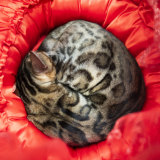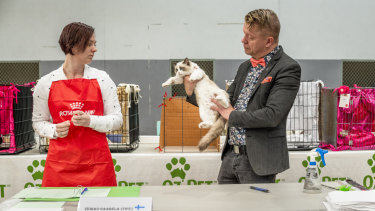News Updates

7/2019
The cats that get the cream: inside the premier shows
The Age, Good Weekend, 13 July 2019
By Jane Cadzow
Patchy the Persian gazes out of his cage, which is lined on three sides by lilac satin curtains. He looks surprised to find himself at the Australian Cat Federation's 47th annual national show, but that may just be his round Persian eyes. Standing nearby is his owner, Samantha Ross, from Kyneton in central Victoria's Macedon Ranges. Ross, 37, is besotted by two-year-old Patchy. Her face lights up when she talks about him. "He's a beautiful boy," she says, pointing out that she is referring not only to his appearance: "He's got a very beautiful nature." Ross beams with pride. She thinks Patchy can win this thing.
More than 350 cats have been entered in the show, held on a June weekend at an indoor sports arena at South Windsor, in Sydney's north-west. In all, they represent 36 pedigree breeds: Abyssinian, American Shorthair, Bengal, Birman, Burmese and so on through the alphabet. Seeing these names in the show catalogue is one thing. Setting eyes on the creatures themselves is another. Early on Saturday morning, as exhibitors lugging pet-packs stream into the arena, I wander around in a state of amazement. I am a cat person. I have always loved cats. But who knew there were so many variations on the theme?
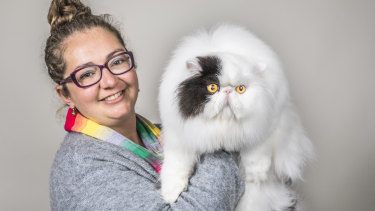
Of course, some breeds and their characteristics are familiar enough. Highly strung Siamese. Adorable Ragdolls, so-called because of their propensity to go floppy when handled. But the Maine Coon, for heaven's sake. It's as big and shaggy as a dog, with the tail of a raccoon. The Toyger, as its name suggests, resembles a miniature tiger. The Lykoi you would swear was related to a werewolf. The Sphynx, hairless and wrinkled, looks like ET. I have read that the late Ann Baker, eccentric Californian breeder of the original Ragdolls, started rumours about cats being genetically modified with DNA from skunks and aliens. This was taken as a sign that Baker had finally flipped, but now I am wondering if she was onto something.
By 8.30am, when judging is due to begin, the cats have been transferred from carry-cases to individual display cages that their owners have decorated with plush fabrics and furnished with comfy beds. While the cats adjust to their surroundings – actually, most appear to be napping – the owners mill about nervously, drinking coffee from disposable cups.
Shara McKay, president of Cats NSW, has warned me that emotions can run high: "It's like putting your child in a beauty pageant. It does become personal."
I ask McKay, a 31-year-old high school teacher who breeds Siamese and Orientals, whether a particular kind of personality is drawn to Catworld, as she refers to the show scene. "You mean the crazy-cat-lady stereotype?" she asks cheerfully. The truth is, showing cats is a hobby that attracts all sorts: "We are very, very different when you get to know us all individually." As far as McKay can see, the only thing she and fellow Catworld denizens have in common is that each owns not just one cat but, well, quite a few. "That's probably the extent of it, the ownership of multiple fur babies."
It's like putting your child in a beauty pageant. It does become personal.
Samantha Ross, whose husband and eight-month-old son have accompanied her and Patchy to the show, says she wasn't allowed to have a cat when she was a child. Her father was allergic to feline hair, so she had to get by with rabbits. Since then, she has been making up for lost time. I am keen to know how many cats she has at home at Kyneton. "Oh, it's bad luck to count," she says. "But, you know … eight. That's okay. Like, that's not a lot." Do they live inside or out? "They live in our house. They sleep on our bed. Except Patchy, who has his own room."
At dog shows, the entrants are judged while parading around a ring with their handlers. At cat shows? Please. Cats don't parade. Instead, their numbered cages are lined up on long tables festooned with bunting, which themselves are lined up to form large, U-shaped bays. A judge stands at a bench in the middle of each bay while a red-aproned steward opens the door of one cage at a time, carefully lifting out the occupant and handing it over for appraisal. The judge spends a few minutes closely inspecting the cat then gives it back to the steward, who returns it to its cage. Over the two days of this show, the cats in each bay will be assessed by six judges, whose scores will be tallied for overall results.
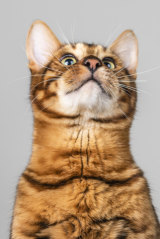
The cats' attitudes to all this vary. I watch as a few of them turn on the charm, delighting the judges by purring and preening, but most exude studied indifference bordering on ennui (You woke me up for this?), and a small number make clear that they are unamused. "Sorry," says judge Peta Sperduty, a vet nurse from northern NSW, to a querulous five-month-old fawn point Siamese kitten. "Did I dare to touch your ears?" In another bay, a three-year-old blue bi-colour Ragdoll hisses at Wollongong judge Tony Hurry, then takes a swipe at him. Hurry is unperturbed. "I'm not holding you tight," he says mildly. "Just you behave."
Overseeing the proceedings is Judith Jordan, the Adelaide lawyer who is Australian Cat Federation (ACF) president. Wearing a black coat with fake fur around the collar, her hair cut in a stylish asymmetrical bob, Jordan says some cats never get used to being handled by judges and ogled by strangers. "It can be an excellent example of the breed, but if it doesn't have a show temperament, then it doesn't really belong on the show bench," she says. "If you care about the animal, you don't force it."
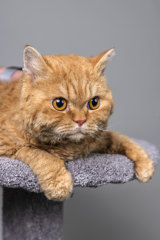
What is unfortunate is when a cat launches happily into a show career only to have its confidence shattered by a traumatic experience. Jordan cites the case of a British Shorthair that was standing on the bench at a Feline Association of South Australia show when "somebody shut a door or dropped something that made a huge noise. I watched that cat leap into the air, dive under the table and smash through the paper bunting, he was so terrified by the sound. And he was never shown again." She pauses. "That was the end of him. Just a nervous wreck." Three of her own nine cats have accompanied her to Sydney: a Russian Blue called Rasputin and a pair of curly-coated Selkirk Rex brothers, Reg and George. The Selkirk Rex breed, while good-natured, isn't noted for its smarts.
"Not a lot goes on between the ears," Jordan says affectionately. Russians have a reputation as intelligent cats but, according to Jordan, Rasputin lets down the side. "Just a bit vacant," is the way she describes him. "His breeder used to say to me, 'My cats look really good but they're stupid.' I didn't actually believe that until I got one of her cats."
Oh well. The judges aren't testing general knowledge. Cat shows are all about physical attributes. "And Rasputin is beautiful," Jordan says. "He's absolutely gorgeous. I mean, look, they're all gorgeous."
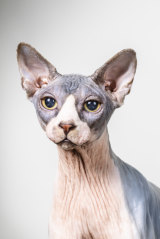
For some reason, it is icy-cold inside the arena. A portion of the crowd, apparently forewarned, has dressed as if for a polar expedition, in puffy jackets and brightly coloured beanies. Otherwise, the sartorial theme is feline. Scarves adorned with pictures of cats. Headbands with sequinned cat-ears affixed. I don't think I've ever seen so much leopard-print in one place. On the sidelines, a stall sells cat-shaped earrings, cat hairclips, cat watches, cat socks and "Cat Pride" T-shirts, along with a wide array of household knick-knacks. On one plaque is the message: Home is where the cats are. On a mug: You say 'crazy cat lady' like it's a bad thing.
In Catworld, men are heavily outnumbered by women but, if anything, they have snappier show wardrobes. Daniel Germishuys, from South Africa, one of six international judges on the panel, is wearing checked blue pants with a waistcoat and watch chain. A Finnish judge, Veikko Saarela, sports a bow-tie. All the judges appear to enjoy their work, but none is more exuberant than Saarela, who occasionally interrupts his professional examination of a cat to whisper in its ear, rub his face on its neck or kiss its tummy. Like his colleagues, he thinks aloud while assessing each animal, sharing his expert opinion with the audience gathered in his judging bay. "Wonderful in body," he says of a mackerel tabby Siberian. "Beautiful in coat quality. Very pretty female in super condition."
I drift from bay to bay, jotting down judges' comments: "Excellent ear placement … Fabulous chest width … Lovely depth to the back of the skull …" Remarks are made about comportment, too ("He's been lying on his back with his feet in the air; quite a ham"), but winsome behaviour will get a cat only so far in a competition of this calibre. The highest scores are given to those that conform most closely to "breed standards" – sets of highly detailed specifications as to what constitutes the perfect Siberian or Snowshoe or Somali or whatever. A Somali, for instance, must have a "firm, lithe" body and a "wedge-shaped head of medium proportions, wide at the top". Its nose must be medium-long ("a bump on the nose is undesirable"), its chin "firm and well-developed", its eyes "wide apart, large, brilliant and expressive; almond in shape and outlined with dark colour". The cat's legs must be "fine and long", its feet "small and oval". Ideally, the Somali "gives the impression of standing on tiptoe".
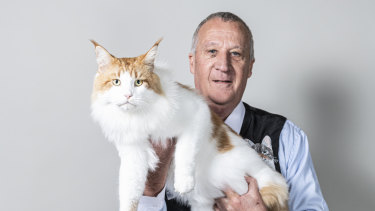
Some judges spell out why they intend to deduct marks. "I'd like the chin to be a touch more forward," says Tony Hurry, as he gives a three-year-old Ragdoll the once-over. "And a bit more silkiness to the coat would be good." Hurry, who is wearing a waistcoat appliquéd with cat faces, believes in keeping his criticisms gentle. "The tail is just a little longer than I'd like," he says of a five-year-old cream Persian. Of another, he says: "Carrying just a bit of extra weight, but so am I."
One breed, the Sphynx, is required to have a big belly. The breed standards rulebook says it must have "the appearance of having eaten a large meal". What's more, it should display "as many wrinkles as possible, especially on the head". Bald, fat and wrinkled, chortles Sphynxowner Debbie Myers. "All the things we don't want to be." Myers drove to the show from Adelaide with a couple of friends in a van, bringing nine Sphynxes between them. I ask how many cats she owns. "Oh, I hate to count," she says. "I'm going to say 10. Nice round number." She adds that, despite having no coat to brush, Sphynxes can be quite high maintenance. For a start, the lack of hair means they need protecting from the elements: they're susceptible to sunburn and feel the cold. At Myers' place, they curl up under blankets she spreads on her couches. "I just say to people, 'Be careful where you sit.' "
You wouldn't want to squash one: a Sphynx kitten can cost more than $2000. "And yet they are, excuse the expression, flying off the shelves," says Fiona Hawkins, a South Australian breeder of Russians, who is working as a steward at the show. The Sphynx is the cat du jour, agrees ACF president Judith Jordan, who has seen feline fashions come and go. A few years ago, people went mad for the Bengal, designed by US breeders to have the aspect of a forest-dwelling wild cat. "All of a sudden, the jungle look was popular," Jordan says. "But yes, at the moment everyone wants a naked one."
Myers and her friends have put heat-pads in their Sphynxes' cages, to offset the Arctic temperature in the arena. Also, they have brought some outfits for them to wear. At one point, I see a Sphynx dressed in a pink ballet tutu. It will be a long time before I can get that image out of my mind.
Showing cats can be both expensive and time-consuming. To keep their animals in tip-top shape, owners fork out for everything from coat-conditioning sprays and ear-cleaning solutions to the fanciest cat foods on the market. Travelling to shows can mean making long road trips or paying for plane tickets as well as motel accommodation and entry fees. In their home states, owners might take their cats to a couple of local shows a month. "Everyone is serious," says American judge Lynne Sherer. "It becomes a very important part of your life." Nevertheless, I detect a sardonic streak in some of the exhibitors I meet at the national. On one hand, they are desperate for their cats to win ribbons. On the other, they can see there is something nutty about the entire caper. "There are a lot of people here with a lot of passion," says Jordan, adding after a moment's thought: "Either that or we're really stupid."
There are a lot of people here at the cat show with a lot of passion … Either that or we're really stupid.
For judging purposes, the pedigree cats are divided into three categories. In group one are "the hairy things", as Jordan refers to Persians, Ragdolls, Birmans and other puffballs. In group two are the Orientals and Siamese. In group three are the short-haired cats. I learn that the owners of group two and three cats tend to regard group one as the epicentre of Catworld wackiness. "It's all that talc and chalk – gets up their noses," jokes one person, referring to the powders used in grooming long-haired cats. Sydney woman Jennifer Bowers suggests that as a journalist, I am wasting my time hanging around in the group two judging area. "See, we're kind of normal," she says. "You need to go down to the fluffy section, because they're way more bizarre."
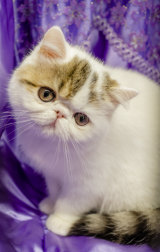
Bowers won't be coming with me. "I stay away from group one people," she says. "They're loons. Not all of them. Some of them are my friends. But some are, like, really weird." Is she thinking of anyone in particular? She lowers her voice. "I'm talking about Persian breeders." In the show catalogue, all the cats are listed under their pedigree names. Reverence Summer Mist. Azov Iron Outlaw. Firestorm Chinook. Mostly, these bear no relation to the names by which their owners address them. Snowgum Jade Dragon might answer to Snookums. Jipushi Moonshine Magic of Love could be Mittens when he's at home. The registered name of Bowers' Oriental Longhair is Templeton The Rockstar, which she shortens to Rockstar. I ask if she has any other moniker for him. "Well, sometimes he gets called Middsy-moo," she says. "But he doesn't like that because he says, 'Mum, I'm a rock star! Don't call me Middsy-moo.' " Bowers grins.
Consulting the breed standard for Persians, I half-expect to read that they "must look like they ran into the back of a bus". The flat face is one of the breed's most distinctive characteristics, and in the opinion of Patchy's owner, Samantha Ross, considerably adds to their cuteness. But Sarah Zito, RSPCA Australia's senior scientific officer with responsibility for companion animals, says the distorted frontal skull shape can adversely affect Persians' health. They can have breathing difficulties, dental disease caused by misaligned jaws, and – because of their big, bulbous eyes – deformed tear ducts that don't drain properly. The compressed Persian profile is a relatively recent development, the result of selective breeding over the past few decades. "I think they looked a lot nicer before, personally," Zito says. "They looked like cats."
Ross knows some Persians have squished features. But not Patchy: "I feel that he's got a really sweet, open expression." The judges apparently like what they see, because so far he's blitzing the opposition in group one. "I'm a bit overwhelmed," Ross says.
In any case, Persians are much better off than Scottish Fold cats, four of which are at the show. Zito explains that the bent-over ears that distinguish the breed are the outward sign of a genetic mutation that affects the development of cartilage, leading to defective bone development as well as severe arthritis. "Some are very badly affected and some are less badly affected, but they are all affected to some degree," she says.
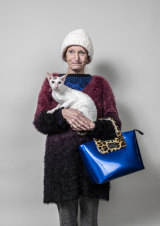
This fundamental flaw is the reason the breed is not recognised by the Fédération Internationale Féline, nor by the UK's premier cat registration body, the Governing Council of the Cat Fancy. That it continues to be bred and shown in Australia baffles Zito, who can only assume lack of understanding is to blame. "A lot of people wouldn't realise that those cats are condemned to a life of pain and suffering."
Zito, who has four rescue cats, reckons it is worth remembering that ordinary moggies have one big advantage over the pedigree variety: "They have a large gene pool, so they don't have the same problems with inherited disorders." Hybrid vigour is much in evidence when I visit the small part of the arena set aside for cats vying for honours in the non-pedigree category. Two three-month-old kittens, one chocolate-coloured, one black-and-white, tumble around their cages like acrobats. Passers-by stop in their tracks, transfixed. Finnish judge Veikko Saarela declares he is in love with them both. Another cat in the group, four-year-old Archie, turns out to be a Bengal without registration papers. Melissa Ross (no relation to Patchy's Samantha), from the central-western NSW city of Orange, says she adopted Archie after he was rescued from a Queensland breeder: "He'd spent his whole life in an outdoor enclosure built for five cats that had 30 cats in it."
Melissa's second entry in the odds-and-sods class, a cat called Boopa, was the pampered pet of a Canberra couple who then had two children in quick succession. "Somebody got very, very jealous," she says, glancing at Boopa. "A lot of anxiety issues. I brought him home and we've worked out that as long as he's the centre of attention, he's happy."
Jennifer Bowers is represented in commoners' corner by a handsome tabby-and-white cat called Ziggy Stardust. For the moment, though, she is more concerned about poor Rockstar, who has run into trouble in group two. The breed standard decrees that the eyes of an Oriental Longhair should be "a vivid, luminous green". Rockstar's eyes are green, Bowers says. "At home they're pea-green. But in this lighting, which is a bit poor, they're not as green as they should be." Consequently, one of the judges has refused to consider him for a ribbon. Bowers is shaken, but determined to keep a lid on any bitterness: "I'm not complaining. I'm just annoyed." I tell her that to me, Rockstar's eyes look green, very green. She smiles in a philosophical way. Cat shows, huh? "There's always a drama."
Judge Veikko Saarela, at right, examines a Ragdoll at the Australian Cat Federation’s national show.CREDIT:TIM BAUER
Catworld is ruled by no less than three national bodies. Apart from the Australian Cat Federation, there's the Co-ordinating Cat Council of Australia (CCCA) and Australian National Cats, known as ANCATS. The ACF and CCCA are umbrella organisations, with their own affiliate groups in the states and territories. In Victoria, for instance, the Feline Control Council of Victoria is attached to the CCCA, while the Governing Council of the Cat Fancy Australia and Victoria belongs to the ACF. On the phone to Brian Edwards, ANCATS president, I say I don't understand why all this duplication exists. He assures me that no one else does, either. "If you can work it out, I'll buy you dinner," he says.
Cheryle U'ren, president of the CCCA (which is having its national show in Sydney on July 20 and 21), says the whole thing is quite harmonious, really: "It's not them and us. We work together."
But Edwards maintains that the ACF and CCCA have disliked each other for as long as anyone can remember, and that both groups have it in for ANCATS. "It's just so petty," he says. "It's crazy. People wonder why the world is in turmoil. The bloody cat clubs can't even get themselves together."
National shows are ruthlessly competitive. "It can get quite bitchy at times," says Tony Hurry. Still, I see signs of camaraderie in the arena. Andrew Fraser, a Selkirk Rex exhibitor from Sydney, moves around offering people slices of his wedding cake. When a rosette is awarded to Layla, a six-year-old black Mandalay owned by Carissa Dyett, from Burpengary, outside Brisbane, Dyett is so thrilled that she starts to sob. This sets off half the Queensland contingent. "You had about 10 of us in tears," I hear someone tell her.
On Sunday afternoon, everyone assembles for the final reckoning. The three highest-scoring cats in group one are presented to five judges, each of whom has another close look at them. The choice of a winner is unanimous: Patchy. Eventually, the judges have the winners of all three groups on the bench in front of them: Patchy, a graceful Oriental kitten and a magnificent Russian Blue. Here comes the big moment. Who will be named Supreme Pedigree in Show? The three contenders are handed slowly from one judge to another. I realise my heart is beating fast. The grand prize goes to … Patchy! Samantha Ross wears an expression of stunned exultation. Patchy, held aloft by a steward, looks surprised, too, but I know now that he looks that way all the time. The eyes.
Within an hour, the crowd has largely dispersed. Judith Jordan, having completed her presidential duties, heads off with her cats, Rasputin, Reg and George. None of them has starred in the show but Jordan doesn't seem to mind. "You always take the best cat home," she says.
